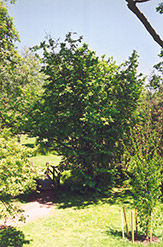It's all about ...
plants

Height: 15 feet
Spread: 10 feet
Sunlight:
![]()
![]()
![]()
Hardiness Zone: 4a
Other Names: European Filbert, European Hazel
Description:
A large sprawling shrub or small tree prized for its commercially produced nuts; a rather large plant, useful for screening or a natural forest setting
Edible Qualities
European Hazelnut is a large shrub that is commonly grown for its edible qualities. It produces brown nuts which are usually ready for picking from early to mid fall. The nuts have a sweet taste.
The nuts are most often used in the following ways:
- Fresh Eating
Features & Attributes
European Hazelnut is draped in stunning brown catkins hanging below the branches from late winter to early spring before the leaves. The flowers are excellent for cutting. It has dark green deciduous foliage. The serrated round leaves turn yellow in fall. It produces brown nuts in mid fall.
This is a dense multi-stemmed deciduous shrub with an upright spreading habit of growth. Its relatively coarse texture can be used to stand it apart from other landscape plants with finer foliage. This plant will require occasional maintenance and upkeep, and can be pruned at anytime. It is a good choice for attracting squirrels to your yard. Gardeners should be aware of the following characteristic(s) that may warrant special consideration;
- Suckering
Aside from its primary use as an edible, European Hazelnut is sutiable for the following landscape applications;
- Hedges/Screening
- Naturalizing And Woodland Gardens
- Orchard/Edible Landscaping
Planting & Growing
European Hazelnut will grow to be about 15 feet tall at maturity, with a spread of 10 feet. It tends to be a little leggy, with a typical clearance of 2 feet from the ground, and is suitable for planting under power lines. It grows at a medium rate, and under ideal conditions can be expected to live for approximately 30 years. While it is considered to be somewhat self-pollinating, it tends to set heavier quantities of fruit with a different variety of the same species growing nearby.
This plant is typically grown in a designated edibles garden. It performs well in both full sun and full shade. It is very adaptable to both dry and moist locations, and should do just fine under average home landscape conditions. It is not particular as to soil type or pH. It is highly tolerant of urban pollution and will even thrive in inner city environments. This species is not originally from North America.
This plant is not reliably hardy in our region, and certain restrictions may apply; contact the store for more information.
